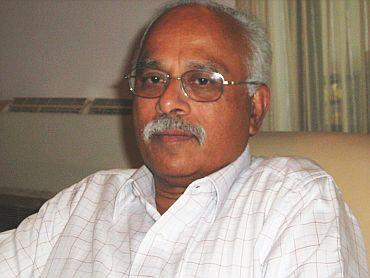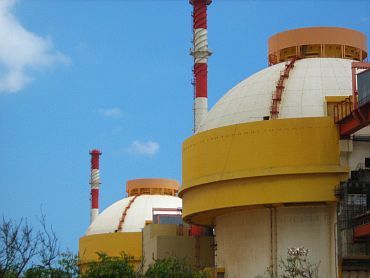 | « Back to article | Print this article |
'No one would be exposed to radiation around the nuclear plant'
Kashinath Balajee is a busy, though worried, man these days. He is the one who will be running India's largest nuclear plant in the next decade -- the Koodankulam Nuclear Power Project in Tamil Nadu -- which has already hit a major roadblock following severe protests over safety concerns about the mega Indo-Russia joint venture.
The KNPP project director has been facing the ire of local protestors, and has also being blamed for the 'communication gap' between the villagers and the government.
In an exclusive conversation with rediff.com's A Ganesh Nadar, Balajee, who had worked in the Kalpakkam nuclear plant for over two decades before taking charge at KNPP in 2003, says his team worked 15 hours a day to get the nuclear plant ready, and now they are sitting idle, thanks to the escalating protests.
How have the protests affected you?
The entire thing is being looked after by the district administration. They are the people who have to ensure law and order. We have workers who stay and work here. There are skilled personnel who come in from outside for specific work.
Work was going on as usual until there was a blockade on October 13. The blockade was lifted only after we promised to stop work here. They warned us that there would be another blockade if work resumed.
We are under the guidance of the district administration as far as the protests are concerned.
What was the status of the Koondankulam nuclear project when you were appointed 2003?
Civil construction was on. The plant machinery had begun to come in slowly. Everything had to come from Russia so it took a lot of time.
Please click NEXT to read further...
'All aspects of public safety have been kept in mind'
Now that everything is over, is the unit is ready to start?
Yes, everything is ready. We just finished a dry run. Let me explain what a dry run is. We run the plant as if it is functioning normally but without the fuel. There is dummy fuel that resembles and takes the physical space of the fuel but does not do anything else. We use steam to create a working environment for the plant and test all the pumps, valves and pipes and the entire structure for leaks.
We simulate a condition when the reactor is active. Actual operation conditions are used to test the various equipment in this plant. The safety systems in this plant were tested.
It has a passive heat removal system. If the grid power supply fails, we have four alternate sources of power independent of the grid. They are diesel plants. Even if there is an unforeseen accident there is something called the core catcher through which can catch any radiation if emitted.
The core catcher has neutrons. In the highly unlikely event of the core melting, it will come in contact with the core catcher which will absorb all radiation generated at that time. Whatever happens in the primary container, the fuel will not come out. The fear that there will be regular radiation coming outside is wrong. The radiation cannot come outside. People working inside, people working outside and then the local public will not be exposed to any radiation.
There is a 1.2 metre thick wall and it has a 6 millimetre steel lining. We have tested the building too. We pumped in air to create 4.6 kg pressure. All tests are done in conditions that are more severe than expected in the normal working conditions of the plant. It was done keeping international standards in mind.
During the hot run the passive heat resistant system has been tested. The diesel generators have been operated and tested as well. If the power from the grid fails we need one diesel generator. We have four. The generators are in a flood-proof, leak-proof building at an elevation of 9.5 metres. Every building in this plant is built 7.5 metres above ground level.
This is above the flood level experienced here. 100 years data of sea level here has been taken into account to decide the mean flood level which is 5 metres if a storm and tsunami occur at the same time.
It is a generation 3 reactor. All aspects of public safety have been kept in mind when we designed it.
How many people work in the nuclear plant?
There is a core group of 800 to 1,000 people who work here. They are supported by another 1,500 persons. These are for the operation of the plant.
For construction there are 4,000 people here. The Nuclear Power Corporation of India also has a thousand people stationed here. Others are contract workers.
'Earlier villagers told us we should speed up work at the plant'
When you did your 'hot run', you did not inform the locals. Thus they got very scared by the loud sounds that were heard when the safety valves were opened to release steam.
When the pressure goes up beyond a certain limit the safety valves are opened to release steam. They did make a frightful din. Maybe if we had communicated this to the villagers, then they would have not been scared. We will definitely do that in future when we test our next plant.
In June we finished building the plant. At that time the villagers used to tell us that they were experiencing a lot of power cuts and we should speed up the work in the plant.
We were supposed to load the fuel at the end of September. We will be able to do it now only when the protests end and the district administration tells us to go ahead.
Is there enough fuel to operate the plant for a year?
There is enough fuel to start the plant. The Russians have assured us of life-time supply.
When will the second plant start?
It will start six months after the first plant does.
And four other plants are expected here?
(Former President) Dr Abdul Kalam was talking about an expansion here. We have the government's clearance and the environmental clearance for four more plants of 1000 MW each.
'We will tell the youth that this plant is for their future'
Have you explained the safety aspects to the protesting villagers?
This plant was planned in 1988. When this place was chosen and the land was acquired, my personal assistant Anbumani was the public relations officer here. He was on deputation from Kalpakkam. He came here and took the villagers to Kalpakkam to show them how a nuclear plant works. They also interacted with the villages around Kalpakkam and came back satisfied.
We have always explained and answered every question they have raised. We have conducted regular seminars in all the surrounding areas. We were doing a public awareness programme before the protests started.
We also invited the self-help women's groups here and told them how the plant and safety equipment work. However, the anti-plant demonstrators have used our precautions as a starting point for their arguments.
We went to the colleges and schools to spread awareness about the plant. Even today I am addressing an institute in Tuticorin. We will go back to the schools and colleges again. We will tell the youth that this plant is for their future when they will require the power.
Why is the church against the KNPP?
I have no idea. I don't know. You will have to ask them. I am willing to speak to them and explain the safety aspects to them.
How long have you been here?
I came to Koodankulam in 2003. After graduating in chemical engineering, I realised I had a passion for nuclear engineering and so I joined the Bhabha Atomic Research Centre training school. Getting through BARC was not easy, as the competition was tough in 1973.
All the leaders in the country's nuclear industry come through the BARC training school. We get trained in all aspects of nuclear engineering. From there I went to a Rajasthan plant. After that I joined the Madras atomic plant. I worked in Kalpakkam for almost 25 years. When I left there I was the plant superintendent in charge of plant operations.
I came here in 2003 and then took over as the station director in 2009.



